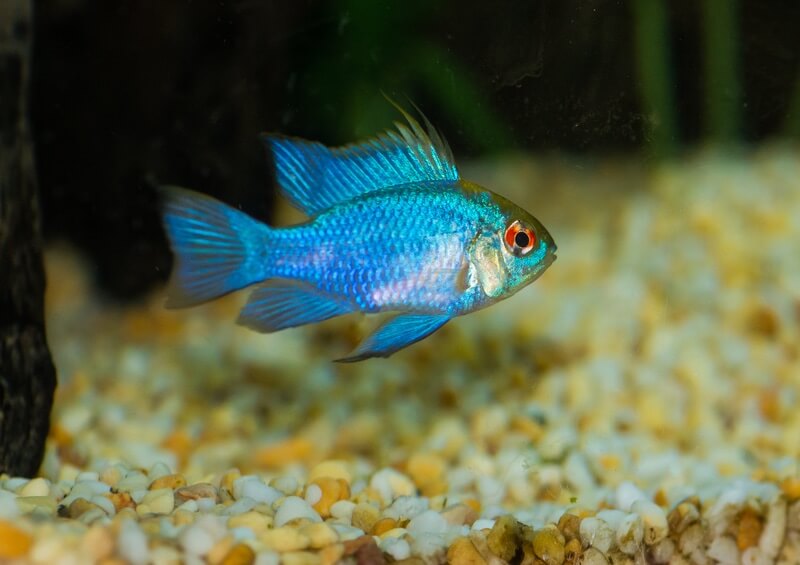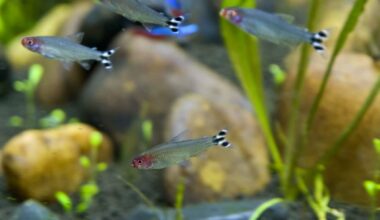Electric blue ram cichlids are eye-catching freshwater fish that aquarists of all ages are interested in. Once you see them swimming around in person, it’s hard to resist the urge to own one!
This guide will teach you the fundamental aspects of electric blue ram care. You’ll learn about their size, lifespan, diet, tank mates, water parameters, tank size, and much more!
Table of Contents
Species Summary
The electric blue ram cichlid (Mikrogeophagus ramirezi) is one of the newer freshwater fish species in the trade. While ram cichlids have been around for decades, this beauty is a product of strategic selective breeding! Its introduction came in 2009, and it’s been a sought-after species ever since.

Getting your hands on an electric blue ram can be challenging, and they often fetch a high price. But if you’re lucky enough to find them in stores or from a breeder, you have the chance to invest in a beautiful aquarium centerpiece!
This fish doesn’t exist in the wild, but the ram cichlids used to create it come from bodies of water in South America. They live in the northern part of the continent and are predominantly found in Venezuela and Colombia. They’re most prevalent in the Orinoco River Basin, where they inhabit slow-moving clear and blackwater streams.
Author Note: While they are a member of the cichlid family, electric blue rams are significantly more easygoing. They’re relatively peaceful fish, albeit with territorial tendencies. But careful planning and suitable tank mates can make those behaviors a non-issue.
Appearance
Electric blue ram cichlids are some of the most breathtakingly beautiful in the fish trade! Years of selective breeding to bring out the stunning coloration paid off, resulting in a vibrant appearance you can’t help but love!
The most defining feature is the color. As the name implies, the fish have a vibrant blue hue. It’s almost neon, and good lighting can make it pop against any backdrop.
The scales are shimmery and have an iridescent sheen. Depending on the lighting conditions, you might see glimmers of green, subtle shades of yellow, and deep purple. The head and belly are usually more subdued with a grayish color.
Like other dwarf cichlid species, electric blue rams have long, rayed fins. The dorsal fin looks spiky and stretches from the gills to just shy of the caudal fin. Complementing the dorsal fin are equally pointed pectoral and anal fins.
High-contrast black stripes are typical on the leading edge of the dorsal and pectoral fins, creating a noticeable outline. Rounding off the most noteworthy physical features are the eyes. They’re bright red and often feature a dot or stripe of black.
Author Note: Distinguishing between males and females can be tough. Unlike most fish species, females are just as vibrant as males. However, the males are usually slightly bigger and have longer dorsal and pelvic fins.
Average Electric Blue Ram Size
Being a dwarf species, these fish aren’t very big at all. The average electric blue ram cichlid size is around an inch and a half in length at full maturity.
That said, some specimens can get bigger. Some of the largest electric blue rams have a recorded length of almost three inches! This has been attained with a combination of genetics and excellent care.
Lifespan
The average electric blue ram lifespan is between three and four years.
That’s the estimated lifespan. As always, substandard care can lead to an early demise. Fish living in poor conditions or those fed a lackluster diet can easily succumb to many diseases.
Author Note: This species, in particular, can be a bit sensitive. The years of selective breeding to achieve that distinct coloration makes the fish vulnerable to stress when kept in a dirty or cramped environment. For that reason, providing proper care and good tank conditions is paramount.
Care
Most hobbyists agree that electric blue ram care isn’t for novice fish keepers. There’s a lot still left to be learned about this species in the aquarist community, but we know that they have many unique requirements that could be too difficult for inexperienced aquarists to meet. Electric blue rams are moderately difficult to keep healthy, so you must remain vigilant about providing the best care possible.
Here are some guidelines to get started on the right foot.
Tank Size
Compared to other cichlids, electric blue rams are on the smaller side. Measuring three inches at the most, they don’t take up a ton of space and don’t require massive aquariums. However, they still need ample room to swim around and establish their territories.
The smallest tank size for an electric blue ram is 20 gallons. That’s big enough for a pair of electric blue rams. If possible, go up to 30 or 40 gallons.
A larger aquarium will allow you to keep more fish in your created habitat and pave the way for a multi-species tank. Bigger is always better with electric blue rams. More space means more flexibility and a lower likelihood of territorial aggression.
Water Parameters
You won’t find any electric blue rams swimming in the wild. However, it’s still wise to model the enclosed habitat you create after the natural environment of wild ram cichlids. That means replicating the conditions of slow streams in South America.

These fish prefer little to no water current. They also like warmer waters with a slight acidity. Alkaline in water isn’t necessarily bad for the fish, but it will hamper breeding and prevent it from reaching its full potential.
As always, establish and cycle your tank as early as possible before acclimating your fish. Give the conditions a chance to stabilize.
Providing stable water conditions is critical when it comes to electric blue ram care. Don’t stop after creating the perfect environment. Monitor conditions regularly to avoid extreme fluctuations and ensure every parameter remains within acceptable ranges.
- Water temperature: 76 to 86 degrees Fahrenheit (Around 82 degrees is optimal)
- pH levels: 6.0 to 7.5 (Slight acidity)
- Water hardness: Up to 10 KH
Tank Setup
The waters of South America are a unique environment to replicate, offering plenty of avenues for creativity. The streams are often surrounded by lush forestation, resulting in an enriching environment for fish.
At the bottom of your tank, use a fine sand substrate. Electric blue rams like to dig every once in a while. But don’t worry: They’re not nearly as destructive as other cichlids!
Within the substrate, you can anchor live plants. These fish love being surrounded by vegetation. They may attempt to uproot them, but they’re not strong enough to damage established plants. Good cultivars for your electric blue ram tank include Amazon swords, anubias, water wisteria, hornwort, java fern, and other plants you can find at your local fish supplier.
Next, you can add enrichment items. Provide your fish with plenty of hiding spots and little things to explore. Not only do these items help keep your fish happy, but they help stave off territorial behavior. Consider adding driftwood, rocks, caves, and overturned flower pots.
Author Note: Here’s an optional tip for you to consider. If you want to help maintain the acidity of the water, try adding a few Indian almond leaves or balls of peat moss to the bottom of the tank. They will deteriorate slowly, releasing tannins like the leaves that fall into natural streams. Replace them regularly, and you can keep the pH level just right.
Finish off your setup with an appropriately sized filter and lights. Use a timer to put the lights on a standard day/night cycle.
Common Possible Diseases
Unfortunately, the inbreeding used to isolate the genes necessary to create electric blue ram cichlids makes this species rather sensitive to poor water conditions. As a result, they can encounter many health issues.
There are no ailments specific to this species, but the fish can suffer from all the usual problems that plague even hardier freshwater fish. The most common disease you have to worry about is Ich.
Ich is a disease caused by protozoan parasites. When conditions aren’t right, electric blue rams become stressed and more vulnerable. That allows the parasites to take hold.
Ich is characterized by white dots all over the body. It’s a contagious disease that will quickly infect others in the enclosed aquarium if you don’t catch it and quarantine the sick fish. The good news is that Ich is easy to treat with over-the-counter medications. But if you don’t take action, it will kill your electric blue rams.
This species is also susceptible to bacterial infections and fungal problems. Bacteria can cause visible lesions on the fins or body. Meanwhile, the fungus will grow on the scales.
Both bacterial and fungal infections are treatable with the proper medications.
However, what’s not always treatable is what some hobbyists call “new tank syndrome.”
This issue occurs when you add electric blue rams to a new tank that has yet to have time to cycle fully. There are no beneficial bacteria to convert ammonia into nitrates. As a result, the bioload of the freshly added fish causes ammonia levels to spike dramatically.
While the fish look fine, they could be dead in a matter of days or weeks. It’s sudden and often comes with zero warning.
Cycle your tank for six to eight weeks to let the conditions stabilize and allow those beneficial bacteria to flourish.
Food & Diet
Despite the sensitivity, there’s one thing that’s pretty easy when it comes to electric blue ram care: Feeding time!
These freshwater fish are opportunistic feeders. In the wild they’re micro predators that feed on insect larvae, fry, and invertebrates.
In captivity, your electric blue rams need a similar high-protein diet. The easiest thing you can feed them is balanced commercial cichlid food. Many high-quality formulas are available, and you can often find options for dwarf cichlids and foods that focus on bringing out that stunning color.
Author Note: When introducing your electric blue rams to the tank, don’t be surprised if they don’t eat. The new environment can cause slight stress that ruins their appetite. Luckily, live, frozen, or freeze-dried food can entice them.
These fish love brine shrimp, tubifex worms, daphnia, and other appropriately sized snacks. Feel free to provide them occasionally as a treat. You can also use those foods to induce breeding.
Feed your electric blue rams two or three times a day and offer enough food to consume in about two minutes. Be mindful of overfeeding. Leftovers can sour the water conditions.
Behavior & Temperament
For the most part, electric blue rams are peaceful. Despite being part of the cichlid family, they’re not aggressors. Unlike other cichlids, you won’t find these fish picking fights for no reason.
That said, you may see territorial behavior from time to time. Electric blue rams like having their own space, and they will get defensive if others invade it. That’s why having a large tank with plenty of decorative items is essential to segment the tank and give every fish room to roam.
Aggressive behaviors may also emerge during breeding, but that’s an easy-to-solve problem that typically goes away once this time passes.
It is possible to keep more than one electric blue ram cichlid in a tank. Females aren’t as territorial as males, so you can have a single male to multiple females. More than one male is possible, too, if the aquarium is big enough.
Usually, groups with more than one male establish a hierarchy of dominance, and one will take the role of leader.
Electric blue rams aren’t schooling fish but often congregate and swim around the tank as a unit. Those groupings are temporary, and the fish often go their separate ways afterward.
Electric Blue Ram Tank Mates
You have many great options for tank mates if you want a multi-species aquarium.
Generally, it’s best to avoid any aggressive and predatory fish. Larger cichlids are out of the question. Electric blue rams stand no chance against bigger aggressors.
It’s also wise to avoid live-bearing fish or any small invertebrates. This species will consume any fry they encounter and often mistake smaller shrimp for food.
Also, steer clear of similarly colored fish. Electric blue rams mistake any with similar bright coloration as other electric blue rams. As a result, dominant males can try to establish their place in a hierarchy those other fish aren’t actually a part of!
Here are some good species to consider as tank mates for your electric blue rams:
- Rasboras
- Most Tetras
- Gouramis
- Otocinclus
- Corydoras
- Dwarf Crayfish
- Large shrimp and snail species
Breeding
If you want to breed electric blue rams, you must establish pairs. This species creates monogamous pairs as juveniles. They have a single partner, and they can continue mating throughout their life.
The best approach is to purchase a group of juvenile electric blue rams and allow them to pair off naturally. Once you have those established couples, you can create your breeding tank.
The tank should have similar decor and water conditions as the primary tank. Add a few flat rocks. Those are the surfaces females will lay eggs on.
Once you add the couple, slowly raise the temperature to around 82 degrees. As you do, condition the fish with high-protein foods.
When ready, the male will clean off one of those flat rocks or dig a pit in the substrate. Then, the fish will perform their mating ritual. It can look a bit aggressive, but it’s a normal process.
The female lays up to 300 eggs on the rock or in the sand pit. You don’t have to remove the parents. Electric blue rams are fiercely protective of the eggs and take turns guarding them as they incubate.
Eggs hatch in about three or four days. Three become free-swimming about five days later. The parents will continue to protect the fry, continually rounding them up into a school.
Provide infusoria, baby brine shrimp, and powdered food to keep the young fish healthy as they grow.
Closing Thoughts
Electric blue ram care is not for beginners, but don’t think you need to be the most experienced aquarist on the planet in order to own this species. As long as you have a realistic understanding of their requirements and are prepared to facilitate what they need, you should find success.
If you happen to have any questions about this fish that we didn’t cover in the care guide, let us know!

